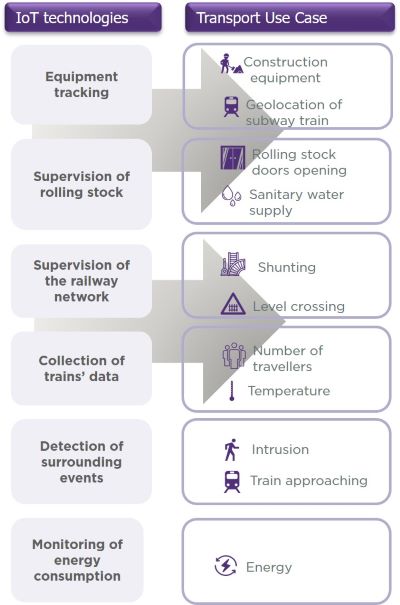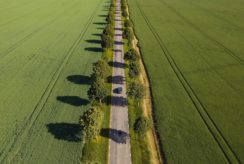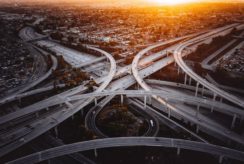Recent news has shown significant investment being made in the rail industry in 2020
The UK Government has given the green light for the HS2, Alstom is set to buy Bombardier train unit in €7.5bn deal and as many as nine operators are introducing new or upgraded trains across the country to meet their promise of replacing Britain’s train fleet, improving the journey of millions of passengers. This wave of investment is expected to drive up the adoption of digital technologies, contributing to an increased exploitation of data such in areas such as ticketing and predictive maintenance.
The year 2020 is expected to mark a turning point with the scaling up of IoT across the sector. We have collected data from several projects and this article presents the most common use cases of IoT in the Public Transport Sector.
Our clients are most interested in IoT technology that could support them in tracking equipment, rolling stock state and monitoring the operations of network installations. This is followed by gathering data on trains’ conditions (number of passengers and temperature), detection of passengers and trains (rail trespassing and alert of train approaching) and monitoring of energy consumption.
Many of IoT use cases in the transport sector can be regrouped according to the frequency established within our clients
Companies seek IoT technologies that can be designed to solve the specific challenges that they are experiencing, and for the Rail sector, these were largely common across our client base:
- Security: Ensuring the safety of customers and employees is a priority in any organisation. IoT sensors make it possible to reduce incidents’ impacts or even prevent the incidents from happening, a common application is the use of sensors for door lock detection and detection of approaching trains.
- Reduction of maintenance costs: Use of sensors to support reactive maintenance will prevent long service interruptions by allowing a quick identification of the nature and location of infrastructure faults. The data collected by such sensors also has the potential to support the implementation of predictive maintenance algorithms when enough data has been gathered.We have observed that companies are ready to invest to address specific challenges, take the example of preventing specific maintenance issues such as failures from points-switching by installing IoT sensors to collect data on maintenance and breakdowns.
- Optimisation of resource allocation (human and material): Optimisation plays a pivotal role in resource management and IoT can be used to improve the allocation of human and material resources. When used to its full capability, it should limit physical surveillance and thus allow human resources to concentrate on value-added tasks. The utilisation of geolocation sensors has showed benefits in reducing equipment loss and time loss. Construction site equipment, for instance, is expensive but reusable and its geolocation saves re-purchasing expenses and the associated search time.
- Improving the quality of service: An increased interest in providing a positive user experience is driving companies to find innovative ways of improving customer satisfaction. This innovation often uses IoT, for example, installing IoT sensors on the platforms and in the trains to obtain occupancy rates and monitoring the cleaning status of rolling stock.
Key Learnings from implementing IoT projects in the public transport sector
The choice or design of IoT sensors for public transport must address specific constraints. When they are scattered over the railway network, the sensors may need to withstand extreme conditions that require them to be highly adaptable to factors such as temperature variations, wind and vibrations. Additionally, the sensor location and the accuracy of data measurements have to be aligned with local transport standards.
As a result, most of the use cases addressed are based on sensors designed by start-ups, SMEs or co-developments within the framework of partnerships due to the lack of standards adapted by the market. The time required for design and approval must be taken into consideration when considering one of previous options.
The deployment of sensors can be time consuming due to the large area to cover, areas of difficult access and the high number of sensors.
IoT connectivity in public transport must address three main constraints: coverage of rural areas, coverage of underground areas and, connectivity when mobile. Although IoT systems can address new use cases, they are not currently envisaged to replace existing Operational Telecommunications networks (e.g. the GSM-R, a cell-based communication network for railway, which allows call prioritisation and allocation of network resources in case of emergency).
Currently, there is not one single IoT platform on the market that addresses the variety of public transport use cases. The choice of an IoT platform must consider at least the following criteria: functional perimeter, integration with the ecosystem, hosting and security. Even when partnering with technology suppliers, companies should expect to make a major effort to develop and integrate their IoT platform (read more about this topic in this article Selecting an IoT platform).
companies in the public transport sector can be structured into many functional and/or territorial entities. In order to achieve homogenisation and rationalisation at group level, it is necessary to adapt organisations to allow the sharing of information across entities and the emergence of group-level standards and solutions. Using data more intelligently and increasing collaboration by either sharing or centralising IoT expertise within the railway industry (and other public transport sectors) would maximise the value from IoT technologies and lead to long-term benefits. However, each organisation has different priorities and ways of working and, centralising or sharing data would require investment from all parties involved.
Organisations must also be committed to supporting the multiplicity of handlers (station staff, maintenance, signalling and shunting, rolling stock drivers, etc.) in taking charge of IoT services to guarantee their adoption.




